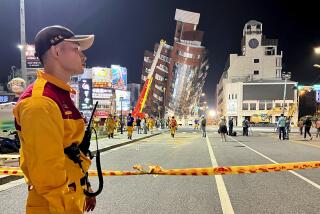Leader Revives Ailing Semtech Corp. : Newbury Park Semiconductor Company Enjoys New Health But Braces for Predicted Industry Downturn
John D. Poe grew up in northeast Montana in a hamlet called Medicine Lake, where his grandfather and father ran a drugstore for 75 years. The younger Poe opted for the electronics business, but heâs brought aid to the sickly as well.
In Poeâs case, the ailing patient was a business, Semtech Corp. in Newbury Park, a tiny semiconductor maker founded in 1960. After humming along for 20 years, Semtech by late 1985 was losing money and in danger of collapse. So it hired Poe.
On his first day on the job, Poe was told Semtech did not have enough money to meet its payroll. That wasnât too surprising since Semtech had lost about $6 million between 1980 and 1985. When Poe arrived, he said, the company âhad very little financial management, or any management that had been able to sit down with the bank and lay out a plan.â
He held his breath and made the payroll, and since has been slowly nurturing Semtech back to health. The company, which lost $4 million on sales of $11 million in its fiscal year that ended Jan. 29, 1985, earned $1.7 million on sales of $19 million in fiscal 1989. In the process, Poe, 37, was paid $216,300 last year and now owns about 6% of Semtechâs stock, worth about $830,000.
Capricious Cycles
But he canât afford to be cocky. Semtech remains subject to the capricious cycles of the semiconductor industry, which affect nearly every company in the field. âWeâd like to believe weâre not, but unfortunately we are somewhat subjectâ to the cycles, Poe conceded.
A full semiconductor cycle is like a roller-coaster ride except that it can last four years. Typically, the ride includes a period when the industry enjoys strong demand, boosts production to fill the big orders and earns healthy profits. Then, as computer manufacturers and other buyers cut back their orders, semiconductor makers find themselves laden with overcapacity and skidding profits.
Now some in the industry think that thereâs a dip coming. âIt seems to me weâre in a decline right now,â said Alan B. Lees, a vice president of Diodes Inc., a Chatsworth semiconductor firm. âThings are not moving ahead as quickly as we would like.â
At Semtech, some of the recent momentum seems to be slowing. The companyâs profit in the fourth quarter that ended in January fell 40% from a year earlier, to $220,000 from $366,000, in large part because industrywide demand for semiconductors flattened. âLast year had two distinct halves,â said Poe, who occupies a modest, cork-paneled office that resembles a high school principalâs office more than a chief executiveâs suite. âOur bookings in the first half were 30% higher than our bookings in the second half.â
So Poe has been building Semtechâs capital to cushion it against the next down cycle by plowing earnings back into the company, conserving cash and issuing securities. Semtechâs cash, a paltry $115,000 at the end of fiscal 1985, totaled $1.7 million in January. The companyâs net worth--its assets minus its liabilities--was $9.2 million at the end of the latest fiscal year, up from $5 million three years ago.
âPower Rectifiersâ
The semiconductors made by Semtech, however, are not the remarkable tiny memory circuits that store huge amounts of information for computers, the so-called âchipâ market that is dominated by Japan. Instead, Semtechâs semiconductors, namely its âpower rectifiers,â serve more mundane purposes. A typical rectifier resembles a small ball bearing with two wires, or leads, sticking out each end that connect with other electronic circuitry. Using 30-year-old technology, Semtechâs rectifiers mainly govern the flow of electrical power not only in personal computers, but in various other products such as jet airplanes and X-ray systems.
Semtech has always focused on the military market, and today about 65% of its semiconductors are sold to military contractors such as Hughes, Westinghouse and Martin Marietta. Poe said Semtechâs products are found on F-14 and F-16 jet fighters and the B-52 bomber. Its commercial customers include airplane makers Boeing and McDonnell Douglas.
Because it mostly serves the military, Semtech is a custom builder of semiconductors that are made to fit the specific power needs, endurance and space limitations of, say, an Air Force jet or missile.
Semtech was started in 1960 by Gustav H. D. Franzen and Harvey Stump Jr., who a year earlier had helped start Diodes Inc. After a year, Diodesâ investors took control of the company, so Franzen and Stump started Semtech with the financial backing of Continental Device, an electronics firm.
By the late 1970s, Semtech was earning about $1 million on annual sales of $15 million. But in 1979-80, Semtech was broadsided by the silver crisis, in which heavy purchases by the Hunt brothers of Texas helped send silver prices from $5 to $50 an ounce. Semtech was using pure silver for all of its rectifier leads, so the silver crisis suddenly sent the cost of its product soaring. After all these years, Franzen is still bitter about it. âThe Hunt brothers sort of killed us,â Franzen said. âThat hurt us tremendously.â
Copper Leads
Scrambling for an alternative, Semtech switched from silver to less expensive copper leads. But copper has much different properties than silver; for instance, at high temperatures, it oxidizes more quickly, rendering the semiconductor useless, Poe said.
âNo one had really sat down to map out what it would take to change the process in going from silver to copper leads,â Poe said. The products did not work, and âSemtech went for a period of six to nine months where there was virtually no product shipped.â
Semtech tried to fix its manufacturing problems, but the company still had not recovered by late 1985, when Poe arrived to confront the manufacturing problems and other headaches.
Franzen was still a director of the company then and was temporarily filling in as Semtechâs president. He recalled that he thought that Poe was to be hired as a financial officer. Instead, as Franzen vacationed in Europe, the rest of the board tapped Poe to be president, he said. âThat caught me completely by surprise,â Franzen said.
A few months later, Franzenâs own ideas werenât getting much attention, so he quit voluntarily, he said. But he still has an interest in Semtech--he owns 50,000 shares of company stock.
Mild Praise
He gives Poe mild praise for helping Semtech--âeverything looks quite good on the surface, I think.â But he asserted that the companyâs change from silver to copper in the early 1980s was by necessity done âin a panic situationâ and that âif we had had the proper time to do it, we could have made the conversion all right.â
For Poe, the lure at Semtech was his first crack at being chief executive. Poe had worked for the semiconductor unit of one-time industry giant Fairchild Camera & Instrument and was vice president for operations at Silicon General, a San Jose semiconductor concern, when he was recruited by Semtech. Poe said he solved some problems at Silicon General and fancied himself as a fix-it man.
His opening move at Semtech was simple: Save money. âThe way you do that is you sign every purchase requisition,â he said, and âabsolutely anything that is not essential to keep the company going, you donât spend it. We were living on checks that we got in that day to pay bills we had to send out that afternoon.â
Poe laid off 70 workers--Semtech today employs 290--and sold a warehouse in Nevada for $600,000, which helped Semtech pare its bank debt. He raised $2 million from investors, thereby padding the companyâs net worth. Most of top management was replaced in 1986-87. The switch to copper leads was finally ironed out.
Investors Cautious
But judging by its stock, investors remain cautious about Semtech. The stock, which closed Monday at $3.25 a share on the American Stock Exchange, has drifted between $3 and $5 for much of the past two years.
Lately, Poe has set up a new microelectronics division that makes more advanced semiconductors for the latest generations of aircraft and other military products.
There is still that roller-coaster semiconductor cycle to worry about. Now that Poe has put the company on healthier financial footing, his said his next task is to âput a strategy in place to maintain that consistent growth.â
But Advanced Micro Devices, one of the semiconductor giants of Silicon Valley that is 50 times Semtechâs size, still sees its fortunes swing up and down at the mercy of the semiconductor cycle. How can tiny Semtech do any better?
âWhen youâre smaller, itâs a little easier,â Poe said.
His idea is that as markets shrink, âwe think weâre quick enough to maintain our business and even grow,â that he can quickly shift his companyâs talented employees into new areas, and that movement is easier than at a bigger company, which has to âtry to move thousands of people around.â
Maybe so. But investors probably will have to wait till the next semiconductor roller-coaster ride comes to a complete stop to see if Poe was right.
SEMTECH AT A GLANCE Semtech is a Newbury Park maker of semiconductors that mainly regulate the flow of power in various products, from airplanes to personal computers. The company, founded in 1960, now has 290 employees and sells about 65% of its products to military customers.
More to Read
Inside the business of entertainment
The Wide Shot brings you news, analysis and insights on everything from streaming wars to production â and what it all means for the future.
You may occasionally receive promotional content from the Los Angeles Times.











